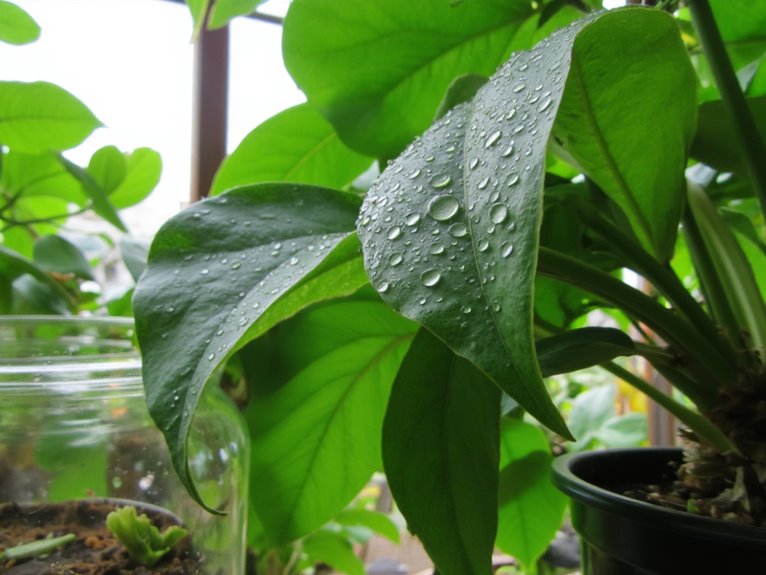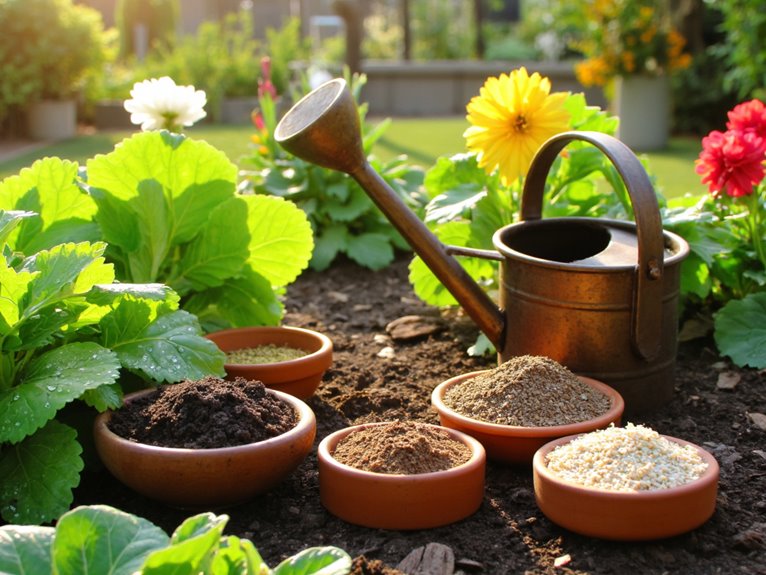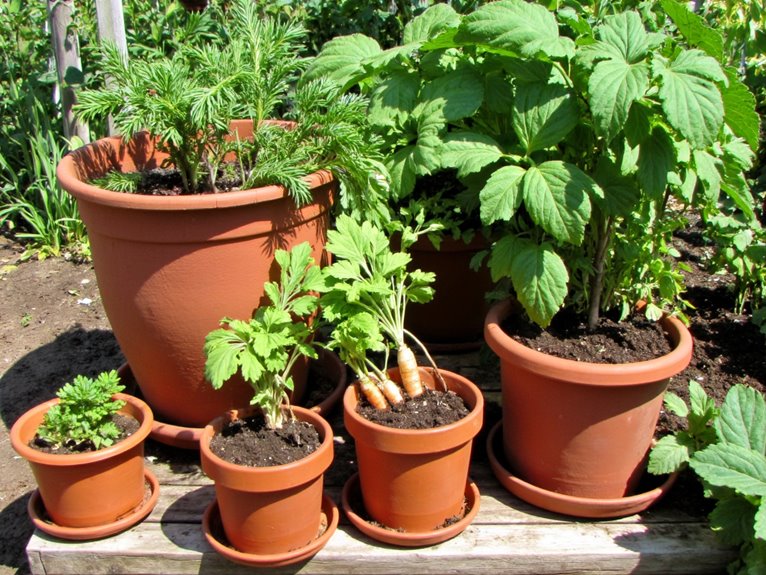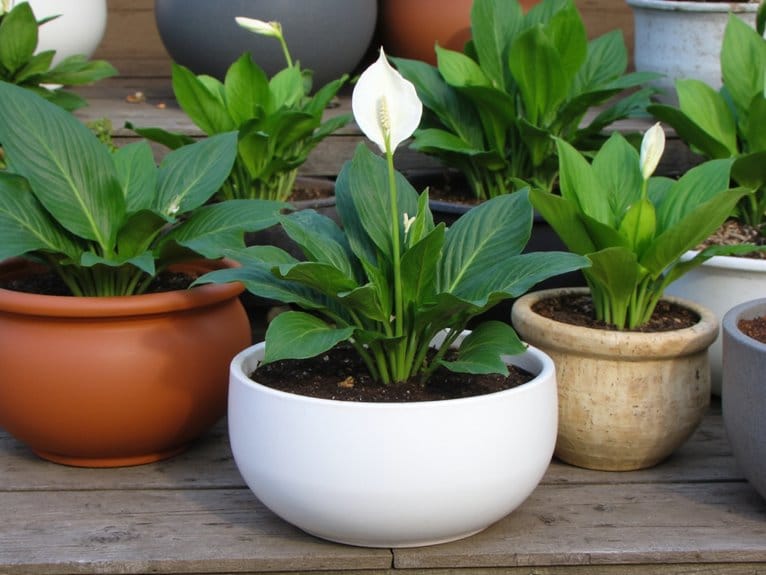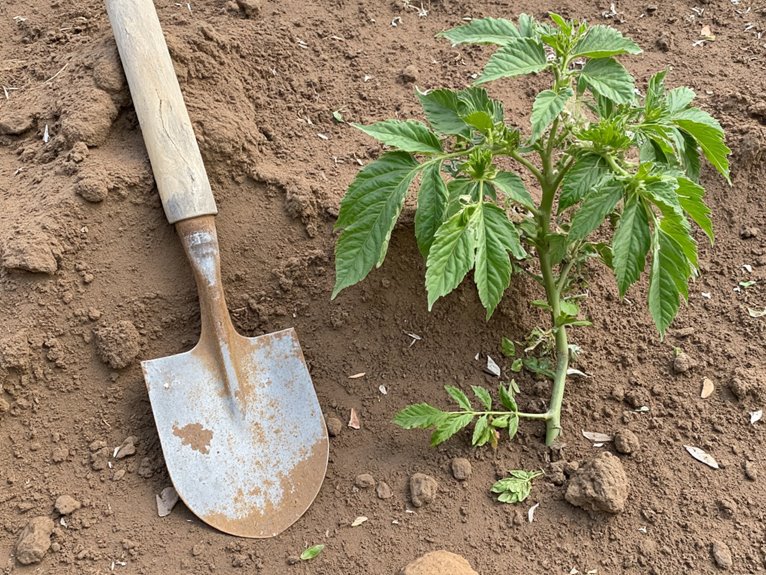African Violet Care for Beginners: The Secret to Continuous Indoor Blooms
You’ve probably heard that African violets bloom year-round – the secret? Bright indirect light, well-draining potting mix, and regular feeding with a 14-12-14 fertilizer. Keep them in pots only slightly larger than their roots to avoid waterlogging, and water carefully to avoid leaf damage. With the right balance of light, nutrients, and care, these blooms will keep coming – just remember to rotate them weekly for even growth!
Notable Insights
- Provide bright, indirect light (1000 foot candles) from windows or grow lights to ensure continuous blooming.
- Use well-draining potting mix with slightly acidic pH to prevent root rot and support nutrient absorption.
- Water consistently with room temperature water using methods like bottom watering to avoid leaf damage.
- Feed monthly with balanced fertilizer (14-12-14 N-P-K) for steady growth and flower production.
- Rotate plants daily and inspect regularly to catch pests or light issues early.
Lighting Needs: Finding the Perfect Balance
Even though African violets thrive in bright conditions, you don’t want to place them in direct sunlight which can scorch their leaves, so finding the right balance is key. These plants need high light intensity—around 1000 foot candles—but not from the sun. Instead, aim for indirect light from windows or artificial sources like T5HO fluorescent bulbs. Light duration matters too; they benefit from 8 to 12 hours daily, with up to 16 for extra blooms. Make sure to rotate them regularly so all sides get equal exposure and avoid letting them lean toward the light source. For indoor growers using artificial lighting, full-spectrum LED grow lights can provide the complete wavelength coverage African violets need while maintaining energy efficiency. By carefully managing both intensity and how long they’re in light, you’ll help your violets grow strong and flower continuously.
Optimal lighting conditions are crucial for African violets to produce their vibrant flowers consistently.
Choosing the Right Potting Mix
After ensuring your African violets get the right amount of bright, indirect light, it’s time to focus on what’s beneath the surface—specifically, the potting mix. A good mix balances moisture retention and drainage using components like sphagnum peat moss, perlite, and vermiculite. These ingredients help maintain a slightly acidic pH between 5.8 and 6.5, which is essential for nutrient absorption. If you’re concerned about sustainability, coconut coir or wood fiber offer eco-friendly alternatives to peat moss. Don’t use regular soil—it’s too dense and can lead to root rot. Instead, create your own mix or choose a store-bought option that prioritizes aeration and pH adjustments with dolomite lime or limestone. Premium organic soils enhanced with beneficial microbes can significantly improve nutrient absorption and overall root health for your African violets.
The right potting mix achieves drainage and moisture retention balance, preventing waterlogged roots while keeping the soil consistently moist—crucially supporting both growth and blooming.
Watering Techniques for Healthy Growth
Once you’ve got your African violets in the right light and potting mix, keeping them watered properly is key to their health and happiness. There are several methods to choose from—self watering pots, bottom watering, wick watering, or top watering—all of which aim to provide consistent moisture without overwatering.
Self-watering pots deliver water through a reservoir, while bottom watering lets plants absorb it from below. A wick system draws water up through a cord, offering steady hydration. Top watering remains popular but requires care to avoid leaf damage.
It’s important to always use room temperature water when hydrating your violets, as they are sensitive to cold temperatures that can shock their roots. No matter the method, check soil regularly and let excess drain away. Finding what works best for your setup will help guarantee those blooms keep coming!
Feeding Your African Violets for Continuous Blooms
When it comes to keeping your African violets in bloom, nutrition plays an essential role—think of it as fuel for their flowering engine. Choose fertilizer types designed for African violets or “bloom boosting” houseplants with nutrient ratios like 14-12-14 (N-P-K) to support both growth and flowers. A balanced formula guarantees your plants get all the essentials without excess nitrogen, which can lead to too many leaves and fewer blooms.
Feed monthly during spring and fall, diluting fertilizer to avoid burning roots. Always use room temperature water to mix with nutrients for best absorption. Consistent feeding helps maintain year-round blooms, especially under bright conditions. Find the right balance, and your violets will reward you with constant color. Just like with container gardening for other houseplants, proper drainage is crucial for African violets to prevent root rot and ensure optimal nutrient uptake.
Creating Ideal Humidity Conditions
Having covered feeding for abundant blooms, we now turn our attention to humidity – a subtle yet significant factor in African violet care. These plants thrive in 70-80% humidity, mimicking their rainforest origins, while levels below 50% cause slow growth and failed blooms. To create ideal conditions, group violets together for microclimate creation or use humidity trays with water and pebbles. Avoid direct misting, which risks rot, and maintain temperatures between 65-80°F. Proper humidity guarantees vibrant foliage and constant flowering, making your African violets truly bloom year-round.
Common Issues and Solutions
Your African violets may show stress through yellow leaves or drooping stems—let’s fix these common problems together. Lighting issues often cause stretching or bleached foliage; find a balance with bright indirect light and rotate your plant regularly. Overwatering leads to wilting and root rot, so let the soil dry slightly between waterings. For pest management, inspect for mites or aphids and use insecticidal soap if needed. Proper plant spacing prevents fungal spread and promotes airflow. Address yellowing leaves by checking watering habits or light exposure. With care, your violets will thrive!
Pruning and Plant Maintenance
As African violets reach for their full potential, careful pruning becomes essential to maintain their beauty and vigor—let’s explore how to keep these plants looking their best. Pruning techniques like removing spent flowers by cutting stems at the base encourage new blooms, while regular leaf care involves trimming three or more bottom leaves monthly to make room for growth. Use small hand pruners or fingers for precision, being careful not to accidentally remove good flowers. For leaf health, inspect regularly and remove damaged or overcrowded foliage. Balance the plant’s shape by pruning uneven growth, ensuring all sides have equal leaf coverage. Pair these techniques with soil leaching to prevent fertilizer buildup and root trimming when needed—this holistic approach keeps your violets thriving year-round.
Propagating African Violets at Home
After achieving that perfect balance of light and care, expanding your collection often starts with something simple—you already have all the materials needed. Propagating African violets begins with careful leaf selection: choose mature, pest-free leaves from the middle or outer rows, cutting stems to 1-1.5 inches. Two main propagation methods exist—water propagation (place stems in water until roots form) and soil propagation (plant directly into a mix of perlite and vermiculite). Maintain temperatures between 72°-80°F, provide indirect light, and use clamshell containers to keep humidity high. Plant cuttings at the correct depth, keeping soil consistently moist but not soggy. With patience, your new plants will bloom within 6-9 months.
Frequently Asked Questions
What’s the Ideal Pot Size for My African Violet’s Leaf Spread?
For your african violet’s leaf spread, aim for a pot that’s one-third the width of the leaves. Use potting techniques like shallow containers and good drainage. Careful leaf care helps growth—too big or small a pot hinders blooms.
How Often Should I Repot My Plant for Optimal Growth?
You should repot your plant every six months for ideal growth, focusing on soil drainage and repotting frequency. Check when the neck reaches an inch above the pot or roots crowd the holes. Use well-draining mix and a clean 4-inch pot to keep blooms coming without over-fertilizing.
Can I Use Regular Garden Soil Instead of a Specialty Mix?
No, you shouldn’t use regular garden soil for your African violets. Soil alternatives like specialty mixes are better because they balance pH considerations and offer proper drainage, aeration, and nutrition for healthy blooms.
Is It Safe to Water My African Violet Directly on the Leaves?
No, it’s not safe to water your African violet directly on the leaves. Leaf watering causes water spots, rot, and disease risks. Prioritize plant health by watering from below to keep foliage dry and roots moist.
Do African Violets Need Any Specific Nutrient Supplements?
Yes, African violets need specific nutrient supplements like balanced fertilizers with ratios such as 14-12-14. Fertilizer types should be liquid, urea-free, and water-soluble to avoid burning roots.
On a final note
With proper care, your African violets will reward you with endless blooms. By balancing light, water, nutrients, and humidity, these plants thrive indoors year-round. Regular pruning keeps them looking fresh, while simple propagation methods let you share their beauty with others. Gardening with African violets builds confidence and connects you to nature—so start today and watch your space transform.
(75 words)

